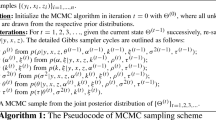Abstract
Conditional autoregressive (CAR) models have been extensively used for the analysis of spatial data in diverse areas, such as demography, economy, epidemiology and geography, as models for both latent and observed variables. In the latter case, the most common inferential method has been maximum likelihood, and the Bayesian approach has not been used much. This work proposes default (automatic) Bayesian analyses of CAR models. Two versions of Jeffreys prior, the independence Jeffreys and Jeffreys-rule priors, are derived for the parameters of CAR models and properties of the priors and resulting posterior distributions are obtained. The two priors and their respective posteriors are compared based on simulated data. Also, frequentist properties of inferences based on maximum likelihood are compared with those based on the Jeffreys priors and the uniform prior. Finally, the proposed Bayesian analysis is illustrated by fitting a CAR model to a phosphate dataset from an archaeological region.
Similar content being viewed by others
References
Banerjee S., Carlin B., Gelfand A. (2004) Hierarchical modeling and analysis for spatial data. Chapman & Hall, Boca Raton
Bapat R.B., Raghavan T.E.S. (1997) Nonnegative matrices and applications. Cambridge University Press, Cambridge
Bell B.S., Broemeling L.D. (2000) A Bayesian analysis of spatial processes with application to disease mapping. Statistics in Medicine 19: 957–974
Berger, J. O., Bernardo, J. M. (1992). On the development of the reference prior method. In J. M. Bernardo, J. O. Berger, A. P. Dawid, A. F. M. Smith (Eds.), Bayesian statistics (Vol. 4, pp. 35–60). New York: Oxford University Press.
Berger J.O., De Oliveira V., Sansó B. (2001) Objective Bayesian analysis of spatially correlated data. Journal of the American Statistical Association 96: 1361–1374
Bernardo J.M. (1979) Reference posterior distributions for Bayes inference (with discussion). Journal of the Royal Statistical Society Series B 41: 113–147
Besag J., Kooperberg C. (1995) On conditional and intrinsic autoregressions. Biometrika 82: 733–746
Buck, C. E., Cavanagh, W. G., Litton, C. D. (1988). The spatial analysis of site phosphate data. In S. P. Q. Rahtz (Ed.), Computer applications and quantitative methods in archeology (Vol. 446, pp. 151–160). Oxford: British Archaeological Reports, International Series.
Case A.C., Rosen H.S., Hines J.R. (1993) Budget spillovers and fiscal policy interdependence. Journal of Public Economics 52: 285–307
Clayton D., Kaldor J. (1987) Empirical Bayes estimates of age-standardized relative risks for use in disease mapping. Biometrics 43: 671–681
Cressie N., Kapat P. (2008) Some diagnostics for Markov random fields. Journal of computational and graphical statistics 17: 726–749
Cressie N., Perrin O., Thomas-Agnan C. (2005) Likelihood-based estimation for Gaussian MRFs. Statistical Methodology 2: 1–16
Cressie N.A.C. (1993) Statistics for spatial data (rev. ed.). Wiley, New York
Cressie N.A.C., Chan N.H. (1989) Spatial modeling of regional variables. Journal of the American Statistical Association 84: 393–401
Gilks W.R., Best N.G., Tan K.K.C. (1995) Adaptive rejection Metropolis sampling within Gibbs sampling. Applied Statistics 44: 455–472
Mardia K.V., Marshall R.J. (1984) Maximum likelihood estimation of models for residual covariance in spatial regression. Biometrika 71: 135–146
Militino A.F., Ugarte M.D., Garcia-Reinaldos L. (2004) Alternative models for describing spatial dependence among dwelling selling prices. Journal of Real Estate Finance and Economics 29: 193–209
Pettitt A.N., Weir I.S., Hart A.G. (2002) A conditional autoregressive Gaussian process for irregularly spaced multivariate data with application to modelling large sets of binary data. Statistics and Computing 12: 353–367
Richardson S., Guihenneuc C., Lasserre V. (1992) Spatial linear models with autocorrelated error structure. The Statistician 41: 539–557
Rue H., Held L. (2005) Gaussian Markov random fields: Theory and applications. Chapman & Hall, Boca Raton
Schott J.R. (2005) Matrix analysis for statistics (2nd ed.). Wiley, Hoboken
Sun D., Tsutakawa R.K., Speckman P.L. (1999) Posterior distribution of hierarchical models using CAR(1) distributions. Biometrika 86: 341–350
Author information
Authors and Affiliations
Corresponding author
About this article
Cite this article
De Oliveira, V. Bayesian analysis of conditional autoregressive models. Ann Inst Stat Math 64, 107–133 (2012). https://doi.org/10.1007/s10463-010-0298-1
Received:
Revised:
Published:
Issue Date:
DOI: https://doi.org/10.1007/s10463-010-0298-1



